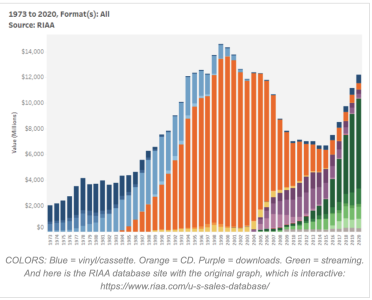Kyle Preston
I Think, Therefore I Ambient
This is exactly what happened. Some economists predicted that for listeners, "unlimited options" would outweigh the risk of illegality through piracy. Whereas others (typically from a psychological bent) fretted over users getting accustomed to cheap or "free" music and would eventually lose their incentive to pay for it.I haven't actually studied it but I feel like something like this must have happened around the Napster days with the perceived value of music. Albums went from $14 to free and so getting people to willingly pay $14 for them again was an uphill battle, and the eventual compromise was streaming services that are really cheap for the consumer (thus palatable as an alternative to pirating, especially with the threat of your ISP coming after you) but it took a really heavy toll on the artists. Right?
What's really interesting though, I read this in Donald Passman's book, is that in the heyday of CD sales, an average CD buyer spent about $45 per year on CDs. But today, if we balance for GDP in the countries that stream music, the average user spends about $7 per month, so $84 a year on music.
That's pretty significant, and is a good argument for subscription. But, it's also worth mentioning that the experience is so different today as a listener. Spotify is more of a content factory where we're all milk cows, and "content" is more important than "albums". So, it's a tradeoff without an easy answer. But interesting none-the-less.





